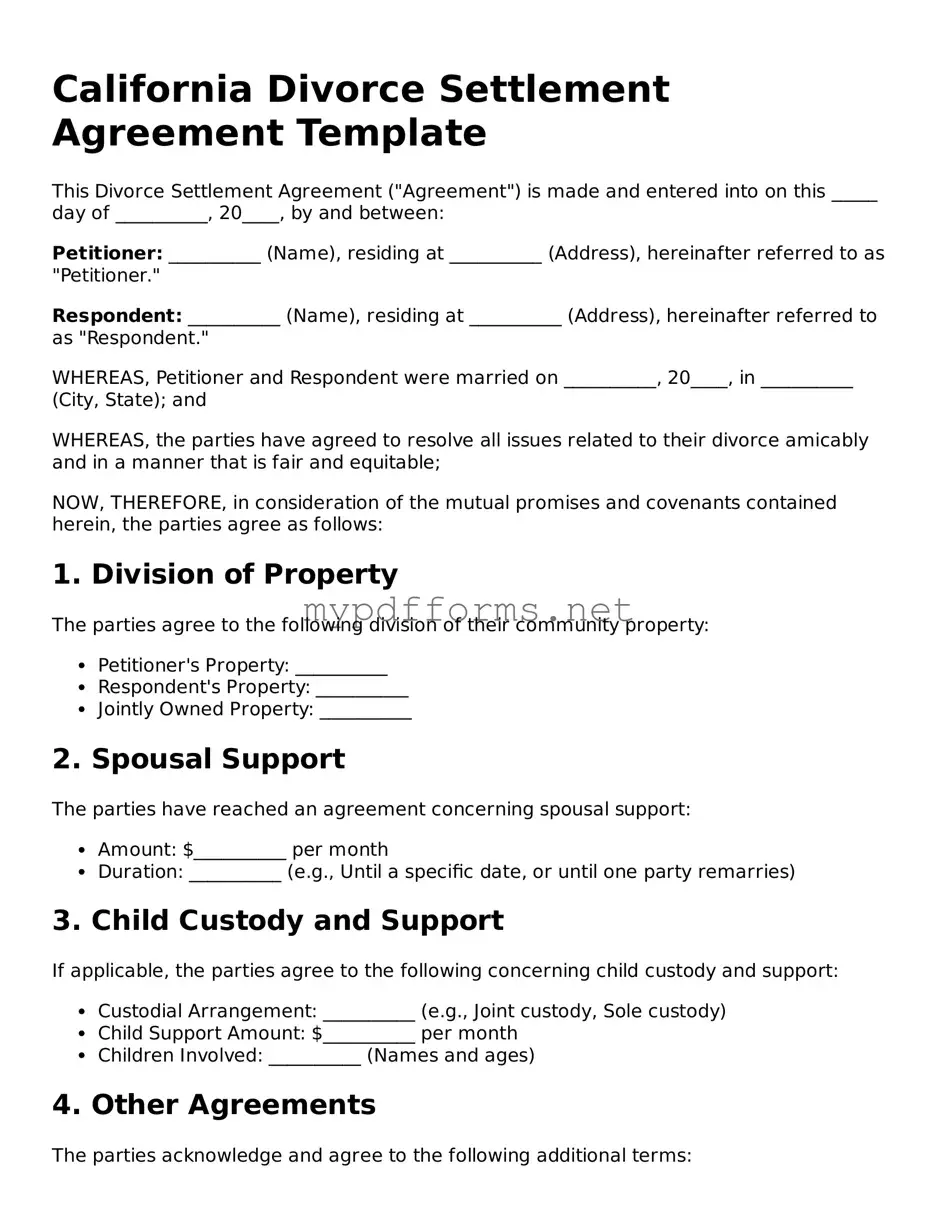The California Child Custody Agreement is closely related to the Divorce Settlement Agreement. Both documents aim to outline the terms of a couple's separation, but the Child Custody Agreement specifically focuses on the arrangements for children. It details aspects such as physical and legal custody, visitation schedules, and decision-making responsibilities. Just like the Divorce Settlement Agreement, this document requires mutual consent and must be approved by the court to ensure the best interests of the child are prioritized.
The Marital Settlement Agreement serves a similar purpose to the Divorce Settlement Agreement. This document outlines how a couple will divide their assets and debts during the divorce process. It includes specifics about property distribution, alimony, and any other financial matters. Both agreements aim to provide clarity and fairness in the division of shared responsibilities and resources, making the transition smoother for both parties.
A Parenting Plan is another document that parallels the Divorce Settlement Agreement. While the latter may encompass broader aspects of the divorce, the Parenting Plan specifically addresses how parents will raise their children post-separation. It includes schedules for parenting time, communication guidelines, and methods for resolving disputes. Like the Divorce Settlement Agreement, it is essential for ensuring that both parents are on the same page regarding their children's upbringing.
The Property Settlement Agreement is akin to the Divorce Settlement Agreement in that it focuses on the division of marital property. This document details which assets and debts belong to each spouse and how they will be handled. Both agreements are crucial in preventing future disputes over property, as they provide a clear framework for what each party is entitled to after the divorce.
The Spousal Support Agreement also shares similarities with the Divorce Settlement Agreement. This document specifically addresses financial support one spouse may provide to the other after separation. It outlines the amount, duration, and conditions of support. Both agreements aim to ensure that both parties can maintain a reasonable standard of living following the divorce.
The Domestic Partnership Agreement can be compared to the Divorce Settlement Agreement, particularly for couples who have chosen not to marry but have established a domestic partnership. This document outlines the rights and responsibilities of each partner, similar to how a Divorce Settlement Agreement details the terms of a marriage dissolution. Both documents serve to clarify expectations and obligations, ensuring both parties are protected.
Before finalizing any sale, understanding the necessary documentation is crucial. For residents navigating the intricacies of vehicle transactions, the Illinois Motor Vehicle Bill of Sale form plays a vital role. To ensure compliance and smooth processing, you can find the appropriate form through Illinois Forms, simplifying the transaction for both buyers and sellers alike.
The Separation Agreement is another document that closely resembles the Divorce Settlement Agreement. This document is often used when a couple decides to live apart but may not yet be ready for divorce. It outlines the terms of their separation, including financial arrangements, child custody, and property division. Like the Divorce Settlement Agreement, it aims to provide a clear understanding of each party's rights and responsibilities during a transitional period.
The Prenuptial Agreement can also be seen as related to the Divorce Settlement Agreement. Although a Prenuptial Agreement is established before marriage, it serves to outline how assets and debts will be handled in the event of a divorce. It sets expectations for both parties, similar to how the Divorce Settlement Agreement clarifies the terms of separation after a marriage has ended.
The Child Support Agreement is another document that aligns with the Divorce Settlement Agreement. This document specifically addresses the financial support one parent provides for their children after separation. It includes details about payment amounts, frequency, and any additional expenses related to the child's upbringing. Both agreements aim to ensure that children's needs are met and that both parents understand their financial obligations.
Finally, the Court Order for Divorce can be compared to the Divorce Settlement Agreement as it represents the final legal decision made by a judge regarding the divorce. While the Divorce Settlement Agreement outlines the terms agreed upon by both parties, the Court Order formalizes those terms and makes them enforceable by law. Both documents are essential in concluding the divorce process and ensuring that all aspects are legally recognized.
